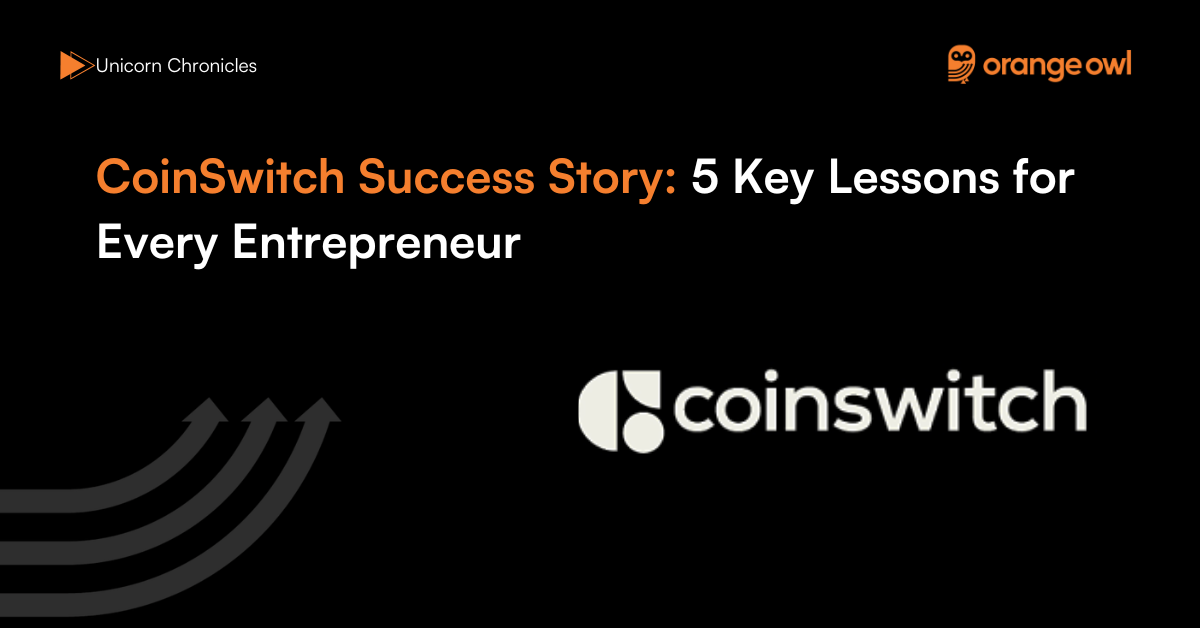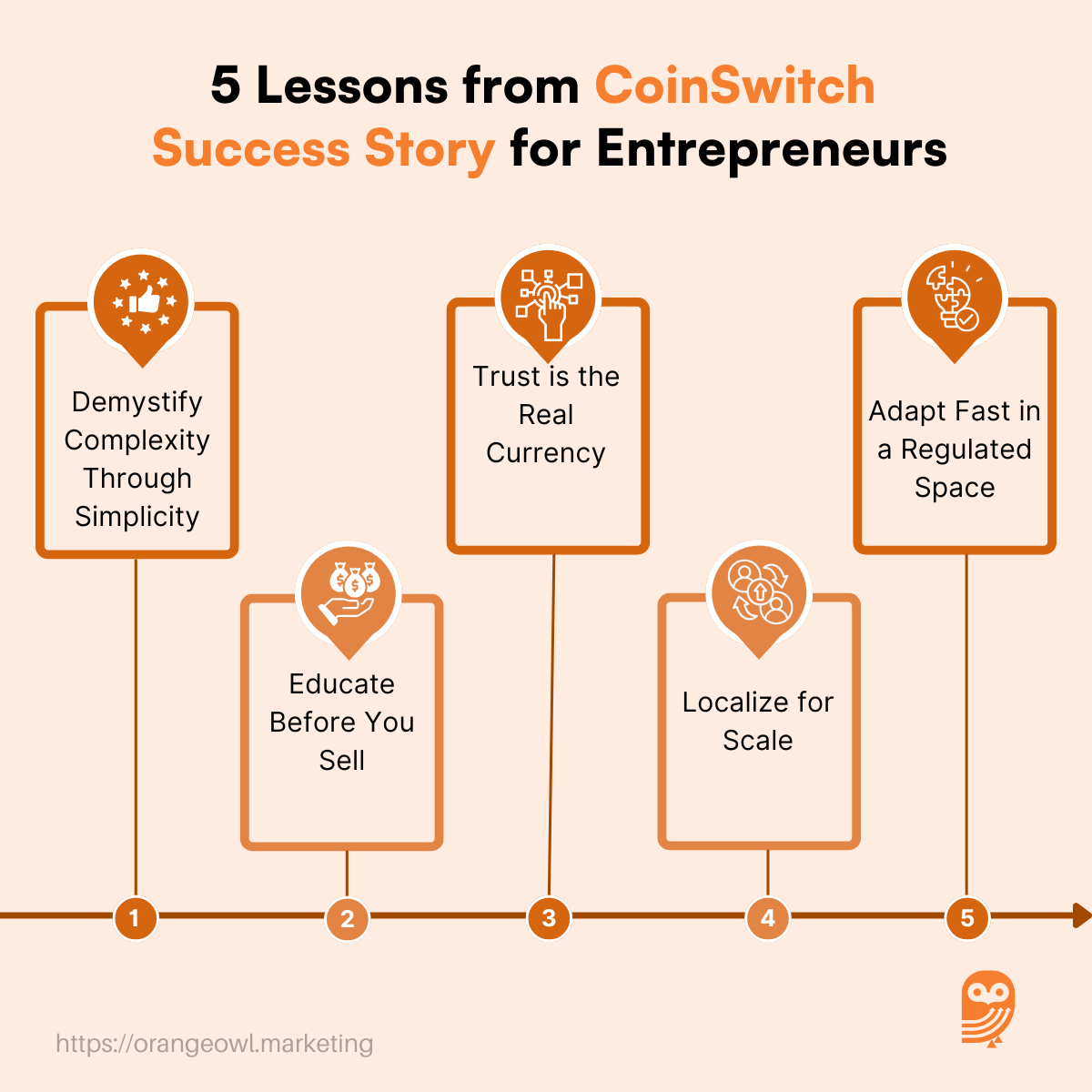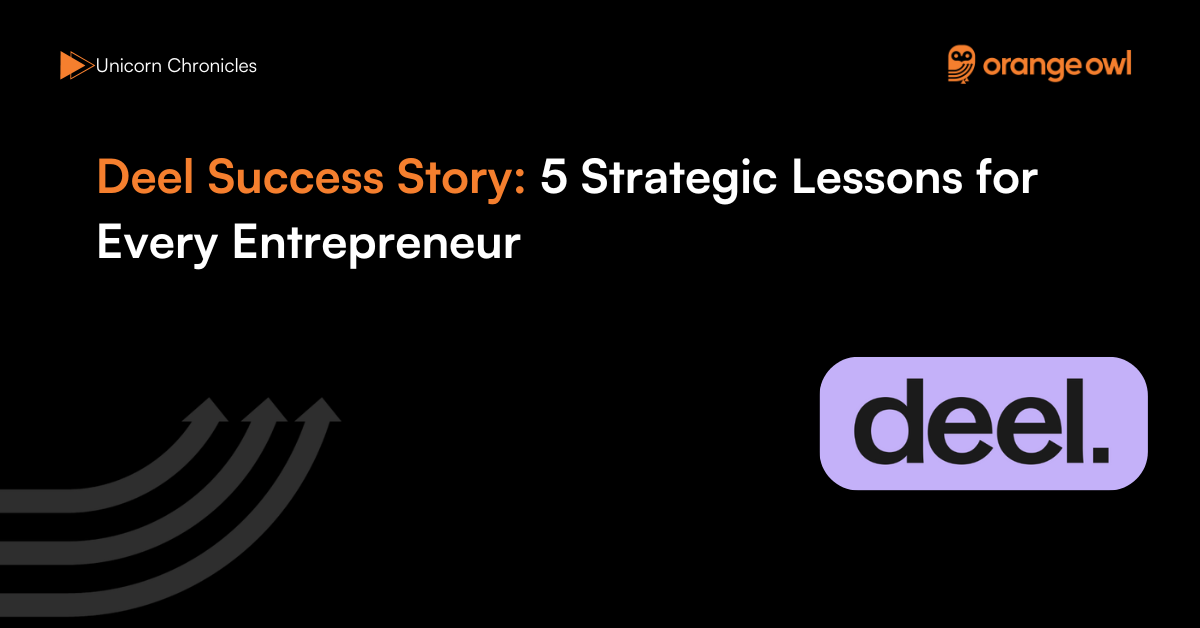CoinSwitch Success Story: 5 Key Lessons for Every Entrepreneur
Vivek Goel
June 11, 2025

Table of Contents
Introduction
In 2017, Ashish Singhal, Govind Soni, and Vimal Sagar Tiwari set out to simplify one of the most complex and misunderstood domains in finance: cryptocurrency. The trio founded CoinSwitch, a digital-native crypto exchange platform, with a bold vision—to make crypto investing accessible, intuitive, and safe for the average Indian user. At a time when buying or trading crypto meant navigating complicated platforms, high entry barriers, and regulatory uncertainty, CoinSwitch aimed to remove the friction and bring clarity to India’s crypto ecosystem.
Singhal, a former software engineer at Amazon and a winner of multiple global hackathons, recognised the need for a platform that demystified crypto for everyday users. With CoinSwitch, the team focused on building a product that went beyond just enabling trades. The goal was to create a user-first, regulation-conscious investment platform—one that combined the ease of a fintech app with the infrastructure strength of a secure exchange.
Rather than catering solely to seasoned traders, CoinSwitch focused on first-time investors, offering systematic investment plans (SIPs), SmartInvest tools, and a clean mobile-first interface that made it easier to invest in cryptocurrencies like Bitcoin and Ethereum. Over time, it added features like API-based trading, crypto deposits and withdrawals, a recovery program for stranded users of other exchanges, and global-standard security protocols—all without compromising on compliance or transparency.
Today, backed by marquee investors such as Tiger Global, Ribbit Capital, and Paradigm, CoinSwitch has raised over $302 million and achieved a valuation of $1.91 billion, making it one of India’s most prominent crypto unicorns. Operating in the B2C FinTech and Blockchain Technology sectors, CoinSwitch stands out in a crowded market of over 1,600 competitors, including global giants like Gemini and domestic leaders like CoinDCX.
The CoinSwitch success story is a testament to how trust, innovation, and user empathy can reshape an entire financial category. In a volatile and rapidly evolving industry, CoinSwitch is proving that with the right mix of technology, transparency, and timing, even the most complex financial assets can become part of India’s mainstream investing culture.
Origin Story
The seeds of CoinSwitch were planted in the minds of three engineers—Ashish Singhal, Govind Soni, and Vimal Sagar Tiwari—who had spent years building backend systems for global tech giants and winning top blockchain hackathons. Ashish, in particular, had worked at Amazon, building scalable systems, but his true calling came during a hackathon where his team developed a crypto trading tool. That experience exposed them to the sheer complexity and lack of user-centric design in the crypto world.
At the time, crypto trading in India was fragmented, intimidating, and deeply technical. Investors had to jump between platforms, calculate exchange rates manually, and often risked getting poor deals. Singhal saw a glaring gap:
“There was no single platform that focused on simplifying crypto investing for the average user. It was built by techies, for techies—but that had to change,” he recalled in an interview.
This insight became the catalyst for something much bigger. Instead of just creating another crypto exchange, the trio envisioned a simple, secure, and regulation-aware platform that could onboard the next million Indian investors—people who didn’t necessarily understand blockchain but were curious about the future of money.
As Ashish put it, “We wanted to become the CoinSwitch, quite literally—the switch that would turn on crypto for India.”
Founded in 2017, CoinSwitch started as an aggregator that allowed users to compare rates across exchanges, but quickly evolved into a full-fledged investment platform. The founders believed that trust, simplicity, and compliance would define the next generation of crypto companies—and they built CoinSwitch accordingly.
In 2021, CoinSwitch became the first Indian crypto unicorn, raising $260 million in its Series C round from marquee investors like Tiger Global, Ribbit Capital, and Paradigm, taking its total funding to $302 million and pushing its valuation to $1.91 billion.
What made CoinSwitch truly stand out was its decision to focus on retail investors, not just traders. With features like SmartInvest, systematic investment plans (SIPs), crypto deposit and withdrawal options, and even a recovery program for users of failed exchanges, CoinSwitch reimagined what a crypto platform could be. It wasn’t just about transactions—it was about trust, accessibility, and financial literacy.
Today, CoinSwitch operates in the B2C FinTech and Blockchain space, competing with over 1,600 global and domestic players, including Gemini, Blockchain.com, and CoinDCX. And yet, its mission remains sharply focused.
As Singhal notes, “We’re not just building a crypto app—we’re building the future of 2 investing in India.”
The CoinSwitch success story began with a belief that crypto could be for everyone, and it continues to evolve as the company rewrites what financial inclusion can look like in the digital age.
Business Landscape and Challenges
When CoinSwitch launched in 2017, it entered a chaotic and uncertain crypto landscape in India, where fragmented platforms, low awareness, and regulatory ambiguity defined the space. Crypto investing was seen as risky and complicated, with platforms offering clunky interfaces and inconsistent pricing. For everyday users, entering the world of digital assets felt intimidating.
The biggest challenge, however, was regulatory uncertainty. In 2018, the RBI’s banking ban on crypto sent shockwaves through the sector. Although overturned by the Supreme Court in 2020, it created a climate of fear and scepticism. Building a trusted crypto platform in such a volatile environment demanded extreme focus on security, compliance, and transparency.
CoinSwitch faced three key hurdles:
- Legal ambiguity: Navigating a grey regulatory space without compromising compliance.
- Low awareness: Educating users who had never heard of blockchain or Bitcoin.
- Poor user experience: Simplifying the fragmented, jargon-heavy process of trading crypto.
Instead of chasing advanced traders, CoinSwitch chose to build a beginner-friendly platform, prioritising simplicity, safety, and ease. Features like SmartInvest, SIP-based investing, and a clean mobile-first interface helped it stand out. As founder Ashish Singhal said:
“For crypto to go mainstream, trust has to come before hype.”
By staying user-centric and regulation-conscious, CoinSwitch succeeded where many stumbled, turning early chaos into a growth opportunity and setting the stage for crypto’s mainstream adoption in India.
Growth Strategies
CoinSwitch’s remarkable growth story is rooted in a series of strategic choices that redefined how Indians engage with cryptocurrency, starting with its decision to target retail investors instead of advanced traders. Rather than build for crypto-native users, CoinSwitch focused on everyday Indians who were curious but cautious, prioritising simplicity, safety, and accessibility.
One of its most impactful moves was streamlining the user experience. The CoinSwitch app eliminated complex charts, confusing order books, and trading jargon, replacing them with clean interfaces, fixed pricing, and instant conversions. This made it possible for first-time investors to buy Bitcoin or Ethereum as easily as they would order groceries online.
The company also embraced education as a growth lever. With initiatives like Crypto Rupee and in-app explainers, CoinSwitch demystified blockchain and tokens, earning trust in a sceptical market. As co-founder Ashish Singhal put it:
“We realised early on that education was not just a feature—it was a foundation.”
In parallel, CoinSwitch launched SmartInvest, a systematic investment tool that enabled users to invest in crypto like they would in mutual funds, promoting long-term thinking over speculation.
Crucially, the startup focused heavily on compliance and regulation readiness, maintaining strict KYC norms, risk monitoring, and collaborating with policymakers to shape the future of crypto in India. This helped position CoinSwitch as a responsible player in a space plagued by scams and volatility.
Together, these product and brand strategies—ease of use, education, SIP tools, and regulatory alignment—allowed CoinSwitch to scale rapidly, becoming India’s most downloaded crypto app and one of the few Web3 startups to gain mass-market trust.
Marketing Strategy
Unlike many crypto platforms that leaned into hype and speculation, CoinSwitch adopted a trust-first, education-led marketing strategy aimed at making crypto feel safe, accessible, and aspirational for everyday Indians.
At the core of CoinSwitch’s marketing was a commitment to financial literacy. The company invested heavily in creating simple, relatable content through YouTube series, blogs, infographics, and social media explainers—breaking down blockchain, tokens, and market trends in plain English (and regional languages). This helped position CoinSwitch as a trusted guide, not just a trading app.
CoinSwitch also focused on mainstreaming crypto through emotional storytelling, with campaigns like “Kuch Toh Switch Karo” that encouraged Indians to rethink traditional investment options. These campaigns weren’t about chasing FOMO, but about building curiosity and comfort around a new asset class.
Additionally, brand partnerships with influencers and fintech voices, rather than crypto evangelists, helped CoinSwitch reach new demographics, particularly millennials and first-time investors who were crypto-curious but hesitant. As co-founder Ashish Singhal shared:
“We wanted people to see crypto not as a gamble, but as a legitimate part of their portfolio—no jargon, no pressure.”
By combining education, empathy, and mainstream relevance, CoinSwitch’s marketing not only drove app downloads but also helped legitimise crypto investing in India’s financial conversation.
5 Key Lessons for Every Entrepreneur
1. Demystify Complexity Through Simplicity
Crypto is often perceived as intimidating and jargon-heavy. CoinSwitch succeeded by making crypto simple and approachable. From easy onboarding and one-click trading to clear UI and regional language support, they stripped away complexity to appeal to first-time investors.
Lesson: If your product solves a complex problem, make the experience as frictionless and friendly as possible.
Even a cutting-edge innovation won’t scale if users feel overwhelmed—design for clarity, not cleverness.
2. Educate Before You Sell
Rather than jumping into aggressive sales, CoinSwitch focused on financial education, launching explainers, blogs, and influencer-led content to help users understand the basics of blockchain and investing. This built trust and lowered barriers to entry.
Lesson: Build user confidence through education, especially when operating in a nascent or misunderstood category.
Informed users are not only more likely to convert, but also more likely to stay loyal and refer others.

3. Trust is the Real Currency
In a space often clouded by speculation and scams, CoinSwitch prioritised transparency and compliance. They registered with Indian authorities, implemented strong KYC protocols, and spoke openly about the risks of crypto investing.
Lesson: When trust is low in your industry, be the brand that communicates with clarity and integrity.
Trust isn’t built through branding alone—it’s earned through consistency, accountability, and openness.
4. Localize for Scale
CoinSwitch didn’t try to replicate global crypto models. Instead, it built India-first solutions—like support for UPI, INR-based pricing, and vernacular campaigns. This localisation unlocked mass appeal across Tier 2 and Tier 3 cities.
Lesson: Tailor your product and messaging to the unique needs of your market, not a global template.
Understanding local behaviours, language, and infrastructure gives you a head start over copy-paste strategies.
5. Adapt Fast in a Regulated Space
Crypto in India has faced frequent regulatory flux. CoinSwitch navigated this uncertainty by staying agile, adjusting operations, maintaining open channels with policymakers, and preparing for both Web3 and compliance futures.
Lesson: In volatile environments, strategic flexibility and proactive regulation-readiness are key to long-term survival.
Don’t fight regulations—co-create your future with them and stay ahead of policy shifts.
Conclusion
The CoinSwitch success story is a powerful example of how clarity, compliance, and consumer focus can turn a volatile industry into a trustworthy opportunity. From its beginnings as a crypto aggregator to becoming India’s most trusted crypto investment platform, CoinSwitch didn’t just follow trends—it set the standard for how to engage first-time investors with confidence and transparency.
In an ecosystem marked by regulatory uncertainty and public scepticism, CoinSwitch leaned on education, simplicity, and user trust. For entrepreneurs building in emerging spaces, their journey proves that responsible innovation beats hype. Whether it was simplifying crypto for the masses, building strong regulatory relationships, or offering a localised, intuitive app experience, every move was driven by long-term thinking and deep user empathy.
As founder Ashish Singhal aptly said, “We are not here to chase hype. We are here to build trust, brick by brick.”
That mindset is what makes CoinSwitch not just a crypto company but a pioneer shaping India’s digital financial future.


